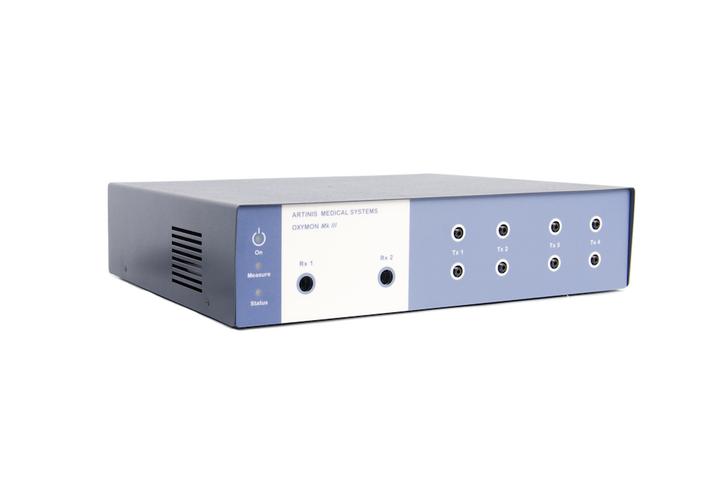
Publications using the OxyMon
Effects of concentric and eccentric cycling training on muscular hemodynamic and erythrocyte rheological responses to exercise in sedentary males
Erythrocyte rheological properties contribute to the dynamic regulation of vascular resistance to flow shear force, facilitating blood delivery from the heart to peripheral tissues. Despite improved physical performance, the effects of eccentric …
Evaluation of Morlet Wavelet Analysis for Artifact Detection in Low-Frequency Commercial Near-Infrared Spectroscopy Systems
Regional cerebral oxygen saturation (rSO2), a method of cerebral tissue oxygenation measurement, is recorded using non-invasive near-infrared Spectroscopy (NIRS) devices. A major limitation is that recorded signals often contain artifacts. Manually …
Physiological and perceptual responses to acute arm cranking with blood flow restriction
Introduction: Lower-body aerobic exercise with blood flow restriction (BFR) offers a unique approach for stimulating improvements in muscular function and aerobic capacity. While there are more than 40 reports documenting acute and chronic responses …
Biomarkers of Peripheral Fatigue in Subjects with Vascular and Neurological Motor Disabilities During an Incremental Treadmill Test Using Near-Infrared Spectroscopy
Peripheral artery disease (PAD) is a progressive atherosclerotic disease that affects textgreater8 million Americans.1 Symptoms of PAD are caused by insufficient arterial blood flow to the lower extremities, which often results in ischemia-induced, …
A feasibility study on using fNIRS brain signals to recognize personal thermal sensation and thermal comfort conditions
Background Many studies have shown some relationships between thermal perception (including thermal sensation and thermal comfort) and human physiological parameters, such as brain signals. However, further research is still needed on how these …
Acute hypoxia impairs posterior cerebral bioenergetics and memory in man
Abstract Hypoxia has the potential to impair cognitive function; however, it is still uncertain which cognitive domains are adversely affected. We examined the effects of acute hypoxia (∼7 h) on central executive (Go/No‐Go) and non‐executive …
Impact of blunted cerebral oxygenation on COPD patients’ functional performance
Introduction: Albeit physical activity (PA) has an important role concerning the health of patients with chronic respiratory diseases, it remains unclear how PA patterns compare among different diseases. Aims: To compare PA levels of 3 major chronic …
Brain activation associated with low‐ and high‐intensity concentric versus eccentric isokinetic contractions of the biceps brachii: An textlessspan style="font-variant:small-caps;"textgreaterfNIRStextless/spantextgreater study
Abstract Studies have shown that neural responses following concentric (CON) and eccentric (ECC) muscle contractions are different, which suggests differences in motor control associated with CON and ECC contractions. This study aims to determine …
Muscle oxygen supply impairment during maximal exercise in patients undergoing dialysis therapy
This study aimed to investigate whether Chronic Kidney Disease (CKD) influences O2 supply including O2 delivery and release to the active muscles during maximal physical exercise. Twelve CKD patients undergoing dialysis therapy (HD group) and twelve …
AltitudeOmics: effects of 16 days acclimatization to hypobaric hypoxia on muscle oxygen extraction during incremental exercise
During incremental exercise muscle deoxyhemoglobin (HHb) and oxygen consumption (V̇o 2 ) both increase linearly, and the slope of their relationship is an indirect index of local muscle O 2 extraction. The latter was assessed at sea level, in acute …
The joint effect and hemodynamic mechanism of PA and PM2.5 exposure on cognitive function: A randomized controlled trial study
Background While PM2.5 has been shown to impair cognitive function, physical activity (PA) is known to enhance it. Nonetheless, considering the increased inhalation of PM2.5 during exercise, the potential of PA to counteract the detrimental effects …
Neural mechanisms of long-term exercise intervention on cognitive performance among short-sleep young adults: A hemodynamic study
Objectives Short-sleep is becoming increasingly common and may negatively affect brain function including cognitive ability. Physical exercise has been proved to improve cognitive function while intensity matters. This study was conducted to examine …
A promising tool to explore functional impairment in neurodegeneration: A systematic review of near-infrared spectroscopy in dementia.
his systematic review aimed to evaluate previous studies which used near-infrared spectroscopy (NIRS) in dementia given its suitability as a diagnostic and investigative tool in this population. From 800 identified records which used NIRS in dementia …
Motor Imagery Decoding Enhancement Based on Hybrid EEG-fNIRS Signals
This study explores the combination of electroencephalogram (EEG) and functional near-infrared spectroscopy (fNIRS) to enhance the decoding performance of motor imagery (MI) tasks for brain-computer interface (BCI). The experiment involved measuring …
Serum brain-derived neurotrophic factor (BDNF) and self-paced time-trial performance in older untrained men
Purpose This study examined the effect of 12 weeks of concurrent aerobic and resistance training on brain derived neurotrophic factor (BDNF) levels, neuromuscular performance and cerebral oxygenation on self-paced cycling exercise in previously …
The Effect of Skeletal Muscle Oxygenation on Hemodynamics, Cerebral Oxygenation and Activation, and Exercise Performance during Incremental Exercise to Exhaustion in Male Cyclists
This study aimed to elucidate whether muscle blood flow restriction during maximal exercise is associated with alterations in hemodynamics, cerebral oxygenation, cerebral activation, and deterioration of exercise performance in male participants. …
The prefrontal cortex hemodynamic responses to dual-task paradigms in older adults: A systematic review and meta-analysis
Background Functional near-infrared spectroscopy (fNIRS) is a method to measure cerebral hemodynamics. Determining the changes in prefrontal cortex (PFC) hemodynamics during dual-task paradigms is essential in explaining alterations in physical …
Diagnosis of Chronic Musculoskeletal Pain by Using Functional Near-Infrared Spectroscopy and Machine Learning
Chronic pain (CP) has been found to cause significant alternations of the brain’s structure and function due to changes in pain processing and disrupted cognitive functions, including with respect to the prefrontal cortex (PFC). However, until now, …
Non-Invasive Mapping of Cerebral Autoregulation Using Near-Infrared Spectroscopy: A Study Protocol
The ability of cerebral vessels to maintain a fairly constant cerebral blood flow is referred to as cerebral autoregulation (CA). Using near-infrared spectroscopy (NIRS) paired with arterial blood pressure (ABP) monitoring, continuous CA can be …